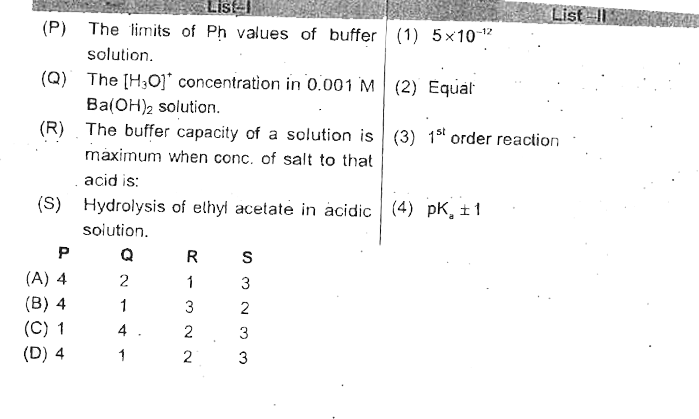Match the following
List - IList - IIA) TrichomesI) CambiumB) Root hairsII) LeavesC) MesophyllIII) UnicellularD) DicotyledonousIV) Epidermal hairs stem
ABCDIVIIIIII
ABCDIIIIIIIV
ABCDIIIIVIII
ABCDIIIIVIII
The correct Answer is:A
To solve the matching question, we need to analyze each item in List - I and find the corresponding item in List - II.
1. Identify Trichomes (A):
- Trichomes are epidermal outgrowths found on the stem of plants. They serve to protect the plant from herbivores and environmental stress.
- Match: A) Trichomes → IV) Epidermal hairs stem.
2. Identify Root Hairs (B):
- Root hairs are extensions of the root epidermis and are responsible for water and nutrient absorption. They are unicellular in structure.
- Match: B) Root hairs → III) Unicellular.
3. Identify Mesophyll (C):
- Mesophyll is a type of tissue found in the leaves of plants and is primarily involved in photosynthesis.
- Match: C) Mesophyll → II) Leaves.
4. Identify Dicotyledonous (D):
- Dicotyledonous plants typically have a cambium layer, which is a layer of actively dividing cells located between the xylem and phloem.
- Match: D) Dicotyledonous → I) Cambium.
Final Matches:
- A → IV
- B → III
- C → II
- D → I
Conclusion:
The correct option that matches all the items from List - I to List - II is the first option.
- Trichomes are epidermal outgrowths found on the stem of plants. They serve to protect the plant from herbivores and environmental stress.
- Match: A) Trichomes → IV) Epidermal hairs stem.
- Root hairs are extensions of the root epidermis and are responsible for water and nutrient absorption. They are unicellular in structure.
- Match: B) Root hairs → III) Unicellular.
- Mesophyll is a type of tissue found in the leaves of plants and is primarily involved in photosynthesis.
- Match: C) Mesophyll → II) Leaves.
- Dicotyledonous plants typically have a cambium layer, which is a layer of actively dividing cells located between the xylem and phloem.
- Match: D) Dicotyledonous → I) Cambium.
- A → IV
- B → III
- C → II
- D → I
The correct option that matches all the items from List - I to List - II is the first option.
Topper's Solved these Questions
- HISTOLOGY AND ANATOMY OF FLOWERING PLANTSBOOK - AAKASH SERIESCHAPTER - HISTOLOGY AND ANATOMY OF FLOWERING PLANTSEXERCISE - EXERCISE - III (PREVIOUS AIPMT/NEET QUESTIONS)
24 Videos
- HISTOLOGY AND ANATOMY OF FLOWERING PLANTSBOOK - AAKASH SERIESCHAPTER - HISTOLOGY AND ANATOMY OF FLOWERING PLANTSEXERCISE - EXERCISE - I (SECONDARY GROWTH)
45 Videos
- ENVIRONMENTAL ISSUESBOOK - AAKASH SERIESCHAPTER - ENVIRONMENTAL ISSUESEXERCISE - Exercise-III (Previous AIPMT/NEET Questions)
41 Videos
- HUMAN HEALTH DISEASEBOOK - AAKASH SERIESCHAPTER - HUMAN HEALTH DISEASEEXERCISE - EXERCISE - III (PREVIOUS AIPMT/NEET QUESTIONS)
56 Videos
Similar Questions
Match List - I and List - II

View SolutionMatch the following
List -I List - II A) False fruit I) BananaB) Pathenocarpic fruit II) Jack fruitC) Aggregate fruit III) Annona(D) Composite fruit IV) Pea V) Apple
View SolutionMatch the following
{:("List - I", "List - II"),("(A) Taeniophyllum","(I) Epiphyte"),("(B) Ground nut","(II) Mangrove plant"),("(C) Vanda","(III) Photosynthetic "),(," roots"),("(D) Rhizophora","(IV) Nodular roots"),(,"(V) Stilt roots"):}
View SolutionMatch the following
List - I List - IIA) Rachis1) Vascular tissues B) China roseII)Peduncle growth islimitedC) VeinsIII) Alternate phyllotaxyD) Cymose IV)Pinnately compound inflorescence leaf
View SolutionMatch List - I and List - II .

View SolutionMatch List - I and List - II .

View SolutionMatch the following tables.
Table - ITable - II A) Cuscuta Pneumatophores B) Eichhornia II) Trap leaves C) Rhizophora III) Parasite D) Utricularia IV) Root pocket
The correct match is
View SolutionMatch the following.
List-IList-III) Tight junctionsA) Cement neighbouring cellsII) Gap junctionsB) Stop leakage of substancesIII) Adhering junctionsC) rapid transfer of ionsIV) EpitheliaD) Upon growing
View SolutionMatch the following.
List-IList-III) Glands without ductsA) Cerimunous glandII) Isolated unicellular glandsB) Islets of langerhansIII) Glands with ductsC) Goblet cellsIV) Glands that produce waxD) Salivary glands
View SolutionMatch the salls in List-I with their use in List-II.

View Solution
